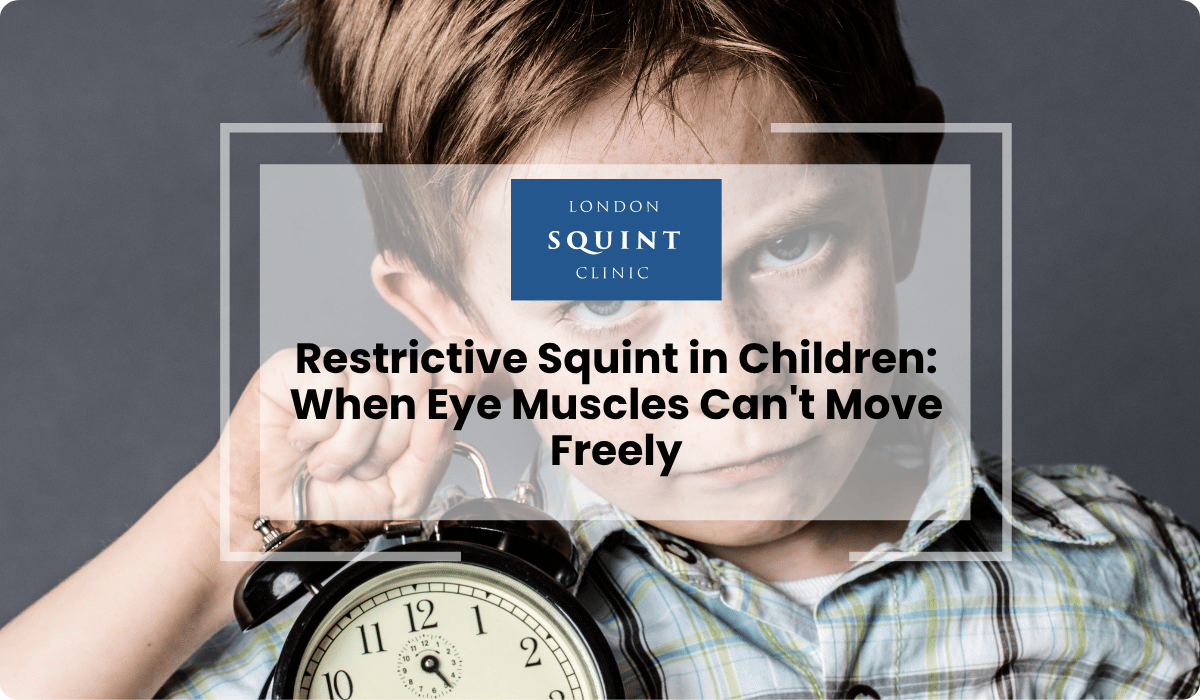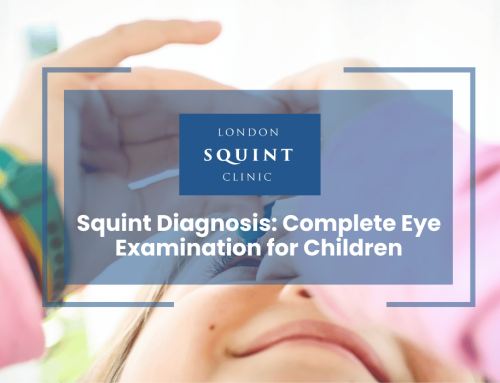Restrictive Squint in Children: When Eye Muscles Can’t Move Freely
Essential Insights for Parents of Children with Restrictive Squint
- Restrictive squint differs from other forms of strabismus as it involves physical limitations to eye movement rather than muscle control issues
- Early warning signs include variable eye misalignment, abnormal head posturing, and limited eye movement in specific directions
- Diagnosis typically requires specialized tests like forced duction testing and imaging studies to identify the exact mechanical restriction
- While non-surgical approaches (glasses, prisms, patching) may help manage symptoms, most true restrictive squints require surgical intervention to address the underlying mechanical limitation
- Early intervention is crucial during the critical period of visual development (up to age 8-9) to prevent permanent vision impairment
- The prognosis varies widely depending on the specific cause, with some conditions responding well to treatment while others may require ongoing management
- Specialist care from a pediatric ophthalmologist with expertise in strabismus is essential for optimal outcomes
Table of Contents
- Understanding Restrictive Squint: Causes and Mechanisms
- Signs and Symptoms: How to Identify Eye Muscle Restrictions
- Why Can’t My Child’s Eye Move Properly? Explaining Mechanics
- Diagnosing Mechanical Squint in Children: Tests and Procedures
- Treatment Options for Restrictive Squint in Pediatric Patients
- Surgical vs. Non-Surgical Approaches to Eye Muscle Restrictions
- Long-Term Outlook: Managing Restrictive Squint Through Childhood
- When to Seek Specialist Care for Limited Eye Movement
Understanding Restrictive Squint: Causes and Mechanisms
Restrictive squint in children, also known as mechanical strabismus, occurs when the normal movement of one or both eyes is physically limited. Unlike other forms of squint that primarily involve neurological or muscle control issues, restrictive squint happens when something physically prevents the eye from moving freely in its socket.
The primary mechanism involves a mechanical restriction that impedes the normal rotational movement of the eyeball. This restriction can affect any direction of gaze but commonly limits upward, downward, or lateral movements. The restriction creates an imbalance in the eye’s positioning, resulting in misalignment that varies with different directions of gaze.
Common causes of restrictive squint in children include:
- Congenital conditions: Brown syndrome (restricted upward movement when the eye turns inward) and Duane syndrome (limited horizontal eye movement with retraction of the eye when attempting certain movements)
- Congenital fibrosis syndrome: A group of rare disorders where the development of eye muscles and nerves is abnormal
- Orbital trauma: Injury to the eye socket that causes scarring or entrapment of eye muscles
- Post-surgical adhesions: Scar tissue forming after eye surgery that restricts movement
- Thyroid eye disease: Though rare in children, this can cause inflammation and swelling of eye muscles
- Orbital inflammation: Swelling around the eye that restricts normal movement
Understanding the specific cause is crucial for effective management, as treatment approaches vary significantly depending on the underlying mechanism of restriction.
Signs and Symptoms: How to Identify Eye Muscle Restrictions
Recognising the signs of restrictive squint in children requires careful observation, as symptoms can sometimes be subtle or mistaken for other eye conditions. Parents and caregivers should be vigilant for these key indicators of eye muscle restrictions:
Observable Physical Signs:
- Noticeable misalignment of the eyes, particularly when looking in specific directions
- Limited movement of one or both eyes in certain directions
- Abnormal head posturing (tilting or turning the head to compensate for limited eye movement)
- Widening or narrowing of the eyelid opening when attempting to look in certain directions
- Retraction of the eye into the socket when attempting certain movements (particularly in Duane syndrome)
- Visible bulging or protrusion of the eye (in cases of thyroid eye disease or orbital inflammation)
Functional Symptoms:
- Double vision (diplopia), especially when looking in particular directions
- Complaints of eye strain or discomfort
- Difficulty with depth perception or 3D vision
- Problems with coordination or clumsiness
- Squinting or closing one eye to see better
- Reading difficulties or losing place when reading
A distinctive feature of restrictive squint is that the misalignment often varies with the direction of gaze. For example, the eyes might appear aligned when looking straight ahead but become misaligned when looking up, down, or to the sides. This pattern differs from non-restrictive forms of squint, which typically show more consistent misalignment.
Early identification is crucial for optimal treatment outcomes and to prevent complications such as amblyopia (lazy eye) or permanent binocular vision impairment. If you notice any of these signs in your child, consulting with a paediatric ophthalmologist specialising in strabismus is recommended for proper evaluation.
Why Can’t My Child’s Eye Move Properly? Explaining Mechanics
Understanding why your child’s eye cannot move properly requires knowledge of normal eye movement mechanics. The eye is controlled by six extraocular muscles that work in coordinated pairs to enable smooth, precise movements in all directions. In restrictive squint, this delicate mechanical system is disrupted.
Normal Eye Movement Mechanics:
Each eye is controlled by six muscles: the lateral and medial rectus (controlling horizontal movement), the superior and inferior rectus (controlling vertical movement), and the superior and inferior oblique muscles (controlling rotational movement). These muscles work in balanced opposition, with one muscle contracting while its opposing partner relaxes.
What Goes Wrong in Restrictive Squint:
In restrictive squint, the problem isn’t primarily with the muscle’s ability to contract (as in paralytic strabismus) but rather with mechanical factors that prevent normal movement. These restrictions can occur for several reasons:
- Fibrotic muscles: The muscle itself may become tight, inelastic, or fibrotic, limiting its ability to stretch when the opposing muscle contracts
- Adhesions: Scar tissue can form between the eye muscles and surrounding structures, tethering the eye and preventing free movement
- Structural abnormalities: In conditions like Brown syndrome, an abnormality in the tendon sheath of the superior oblique muscle restricts movement
- Orbital constraints: After trauma, the bones of the eye socket may trap portions of the eye muscle (orbital floor fractures can trap the inferior rectus muscle)
- Muscle replacement: In Duane syndrome, the lateral rectus muscle is innervated by the wrong nerve, causing co-contraction and restriction
When examining a child with suspected restrictive squint, ophthalmologists assess the pattern of limitation. For example, if the right eye cannot move upward when looking to the right, this suggests a problem with the right inferior oblique muscle or a restriction of the right superior oblique muscle.
Understanding these mechanics helps explain why treatment approaches for restrictive squint differ from those used for other types of strabismus, often requiring surgical intervention to release the restriction rather than just strengthening or weakening muscles.
Diagnosing Mechanical Squint in Children: Tests and Procedures
Accurate diagnosis of restrictive squint in children requires specialised testing to differentiate it from other forms of strabismus. Paediatric ophthalmologists employ several diagnostic procedures to identify the presence, cause, and extent of mechanical eye movement restrictions.
Initial Assessment:
- Comprehensive eye examination: Evaluating visual acuity, refractive errors, and overall eye health
- Ocular motility testing: Assessing the range and quality of eye movements in all directions of gaze
- Cover/uncover test: Detecting and measuring the degree of misalignment in different gaze positions
- Prism and alternate cover test: Quantifying the angle of squint in various directions of gaze
Specialised Diagnostic Tests:
- Forced duction testing: This critical test for diagnosing restrictive squint involves gently grasping the eye with forceps and attempting to rotate it in the direction of limited movement. Resistance to passive movement confirms a mechanical restriction. In children, this test is typically performed under anaesthesia.
- Active force generation testing: Assessing the strength of the muscle by measuring the force it can generate when stimulated
- Saccadic velocity measurements: Evaluating the speed of rapid eye movements, which may be altered in restrictive conditions
Imaging Studies:
- Orbital MRI: Provides detailed images of eye muscles, nerves, and surrounding structures to identify structural abnormalities, fibrosis, or inflammation
- CT scan: Particularly useful for evaluating orbital fractures or bony abnormalities that may cause restriction
- Ultrasound: Can help identify muscle thickening or other soft tissue abnormalities
Additional Assessments:
- Binocular vision testing: Evaluating how well the eyes work together
- Sensory testing: Assessing for suppression, amblyopia, or abnormal retinal correspondence
- Thyroid function tests: When thyroid eye disease is suspected
- Genetic testing: For suspected congenital fibrosis syndromes or other inherited conditions
The pattern of limitation is particularly important in diagnosis. For example, limited elevation in adduction (looking up and inward) suggests Brown syndrome, while limited abduction with globe retraction points to Duane syndrome. These distinctive patterns help guide the diagnostic process and subsequent treatment planning.
Treatment Options for Restrictive Squint in Pediatric Patients
Managing restrictive squint in children requires a tailored approach based on the specific cause, severity, and impact on vision development. Treatment aims to improve eye alignment, enhance binocular vision, prevent amblyopia, and address any underlying conditions. Here’s a comprehensive overview of treatment options available for pediatric patients with mechanical eye movement restrictions:
Conservative Management:
- Observation: For mild cases with minimal functional impact, careful monitoring may be appropriate, especially in very young children where some conditions might improve spontaneously
- Glasses: While not directly addressing the restriction, glasses can correct any associated refractive errors and may improve overall visual function
- Prism therapy: Special prisms incorporated into glasses can help compensate for misalignment in some cases, reducing double vision
- Patching therapy: If amblyopia (lazy eye) has developed, patching the stronger eye helps strengthen vision in the affected eye
Medical Interventions:
- Anti-inflammatory medications: For restrictions caused by inflammation (such as thyroid eye disease or orbital inflammation), corticosteroids or other anti-inflammatory drugs may reduce swelling and improve movement
- Botulinum toxin (Botox) injections: In some cases, Botox can be used to temporarily weaken opposing muscles, though this is less effective in purely restrictive conditions than in other forms of strabismus
Surgical Approaches:
- Restrictive tissue release: Surgical removal of adhesions, scar tissue, or fibrotic bands that are limiting eye movement
- Muscle recession: Repositioning a tight or fibrotic muscle to allow greater range of motion
- Transposition procedures: Repositioning functional muscles to compensate for restricted ones
- Adjustable sutures: Allowing fine-tuning of muscle position after surgery, though this is more commonly used in older children and adults
- Orbital decompression: In severe thyroid eye disease, creating more space in the orbit to reduce pressure and restriction
Rehabilitative Therapies:
- Orthoptic exercises: Specific eye exercises to improve coordination and binocular vision after surgical correction
- Vision therapy: Structured program to enhance visual skills and binocular function
The timing of intervention is crucial, particularly during the critical period of visual development (up to approximately age 8-9). Early treatment helps prevent permanent visual impairment and promotes the development of normal binocular vision. The treatment plan is typically developed by a pediatric ophthalmologist specialising in strabismus, often in collaboration with orthoptists and other specialists as needed.
Surgical vs. Non-Surgical Approaches to Eye Muscle Restrictions
When managing restrictive squint in children, the decision between surgical and non-surgical approaches requires careful consideration of multiple factors. Each approach has distinct advantages, limitations, and appropriate applications depending on the specific condition and individual patient needs.
Non-Surgical Approaches: Benefits and Limitations
Non-surgical management may be appropriate for:
- Mild restrictions with minimal functional impact
- Cases where the restriction might resolve spontaneously (as in some inflammatory conditions)
- Temporary management while awaiting optimal timing for surgery
- Children who are poor surgical candidates due to other health concerns
Benefits of non-surgical approaches include avoiding the risks associated with anaesthesia and surgery, less disruption to the child’s routine, and potentially lower costs. However, non-surgical methods have significant limitations in truly restrictive conditions, as they cannot directly address the mechanical limitation of movement.
Surgical Approaches: When and Why They’re Necessary
Surgery becomes necessary when:
- The restriction is significant and unlikely to improve without intervention
- There is a substantial impact on binocular vision or risk of amblyopia
- The child has developed an abnormal head posture to compensate for the restriction
- Non-surgical approaches have failed to adequately address the problem
- The specific condition (such as Brown syndrome or severe Duane syndrome) typically requires surgical correction
Surgical procedures for restrictive squint are typically more complex than those for non-restrictive strabismus. They often involve releasing restrictions rather than simply strengthening or weakening muscles. The specific surgical technique
Frequently Asked Questions
What is the difference between restrictive squint and other types of squint?
Restrictive squint occurs when there is a physical limitation preventing normal eye movement, such as scar tissue, fibrotic muscles, or structural abnormalities. Other types of squint (strabismus) typically involve neurological or muscle control issues. The key difference is that in restrictive squint, the eye cannot move freely in certain directions due to mechanical barriers, while in non-restrictive squint, the problem lies with muscle coordination or nerve function. Restrictive squint often shows variable misalignment depending on gaze direction.
At what age should restrictive squint be treated in children?
Restrictive squint should be evaluated and treated as early as possible, ideally during the critical period of visual development (up to approximately age 8-9). Early intervention helps prevent permanent visual impairment such as amblyopia (lazy eye) and promotes normal binocular vision development. The specific timing of treatment depends on the cause, severity, and impact on vision, but prompt assessment by a pediatric ophthalmologist is recommended once symptoms are noticed.
Can restrictive squint resolve on its own without treatment?
Most cases of true restrictive squint will not resolve without intervention, particularly those caused by congenital conditions, structural abnormalities, or scarring. However, some cases of restriction due to inflammation or swelling may improve as the underlying condition resolves. Even in these cases, monitoring by an eye specialist is essential to ensure proper visual development and to intervene if spontaneous improvement doesn’t occur.
How successful is surgery for restrictive squint in children?
Success rates for restrictive squint surgery vary depending on the specific condition, severity, and cause. Generally, surgery can improve eye alignment and movement in 70-90% of cases. However, some complex cases may require multiple surgeries, and complete normalization of eye movements may not always be possible. The goal of surgery is to achieve the best possible functional outcome, including reduced double vision, improved head posture, and enhanced binocular vision, even if perfect alignment isn’t achieved.
What are the risks of leaving restrictive squint untreated?
Untreated restrictive squint can lead to several complications, including permanent amblyopia (lazy eye), loss of binocular vision and depth perception, abnormal head posturing that may cause neck and back problems, social and psychological impacts due to visible eye misalignment, and potential worsening of the restriction over time. Early intervention is crucial to minimize these long-term consequences and optimize visual development.
How can I tell if my child’s squint is restrictive or non-restrictive?
While a definitive diagnosis requires professional evaluation, signs that may suggest restrictive squint include: limited eye movement in specific directions, variation in the degree of misalignment depending on gaze direction, abnormal head posturing to compensate for limited movement, and visible retraction of the eye when attempting certain movements. If you notice these signs, consult a pediatric ophthalmologist who can perform specialized tests like forced duction testing to confirm a restrictive cause.
Will my child need vision therapy after surgery for restrictive squint?
Many children benefit from vision therapy or orthoptic exercises after surgery for restrictive squint. These rehabilitative approaches help strengthen binocular vision, improve eye coordination, and maximize the functional outcome of surgery. The need for post-surgical vision therapy depends on factors such as the child’s age, the duration and severity of the squint before treatment, and whether amblyopia or other visual processing issues are present. Your ophthalmologist will recommend an appropriate post-surgical rehabilitation plan based on your child’s specific needs.
Find out if you are suitable for Double Vision Treatment
Not everyone is eligible for double vision surgery.
Find out if you could benefit from this life-changing surgery by taking the quick self-suitability quiz below:
Our most popular procedures

Hello, I’m Nadeem Ali
I’m one of the few eye surgeons in the world with 100% focus on Squint and Double Vision Surgery.
I have 24 years of eye surgery experience, and worked for 13 years as a Consultant at London’s renowned Moorfields Eye Hospital.
In 2023, I left the NHS to focus fully on treating patients from across the world at the London Squint Clinic. You can read more about me here.
There’s lots of information on the website about: squint surgery, double vision surgery and our pricing.
The most rewarding part of my job is hearing patients tell me how squint or double vision surgery has changed their lives. You can hear these stories here.
Mr Nadeem Ali
MA MB BChir MRCOphth FRCSEd(Ophth)





